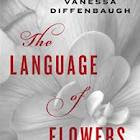I'm starting with the last book I finished first, a recommendation from my sister Amy, The Language of Flowers by Vanessa Diffenbaugh. Keep in mind that when you go shopping for the book, you need to remember the author's name; otherwise, you might end up with a botanical handbook instead. (Just as one of Amy's book club friends, when the group read Rules of Civility, bought George Washington's manual, rather than the novel taking its name from the same, and wondered why anyone made that choice).
I had hardly started reading the novel when I started thinking of the specific people I wanted to tell to read this book. The book opens on what is the legal eighteenth birthday of Victoria, as her social worker comes to take her away from the group home where she has been living after a number of foster homes and failed adoptions. Given a place to live for six weeks while looking for a job and a place to live, she instead uses the time transplanting plants, especially flowers, from all over San Francisco to the park where she will hide out and sleep once her time runs out.
The sections of the novel told as flashback reveal the source of her obsession with "the language of flowers" and of her mistrust of others and her own self-loathing, her life with Elizabeth, a single woman who owns a family vineyard and who plans to adopt Victoria. Diffenbaugh moves between the past and the present seamlessly, drawing the two parts of Victoria's life together when she meets a gentle flower vendor who shares her private language of flowers. Grant proves patient enough to allow Victoria to overcome her personal barriers to relationships.
Among the secondary characters Diffenbaugh creates to people her stories is Renata, the florist who sees through an inexperienced homeless girl and gives her a chance to use her gift, as well as Renata's family, who walk right past Victoria's protective wall and care about her.
I frequently do little more than skim the afterword and other material following the end of a novel, but (after midnight) I read through the alphabetized list of flower and their meanings in the appendix, and noticed the mention of the Camellia Network, "a nonprofit organization [established by Diffenbaugh] dedicated to helping youth make a successful transition from foster care to adulthood." For personal reasons, this is a cause touching my heart. Before I start the next book on my list (or my syllabi for the new semester), I plan to learn more about this particular cause.







No comments:
Post a Comment